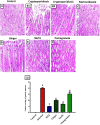Therapeutic Potency of Ginger, Garlic, and Pomegranate Extracts Against Cryptosporidium parvum-Mediated Gastro-Splenic Damage in Mice
- PMID: 36348178
- PMCID: PMC10011320
- DOI: 10.1007/s11686-022-00635-0
Therapeutic Potency of Ginger, Garlic, and Pomegranate Extracts Against Cryptosporidium parvum-Mediated Gastro-Splenic Damage in Mice
Abstract
Purpose: Cryptosporidium parvum is a protozoan parasite infecting most mammalian hosts and causing major health issues. The present study investigated the efficacy of ginger (Zingiber officinale), garlic (Allium sativum), and pomegranate (Punica granatum) peel extracts on the development and progression of experimental cryptosporidiosis in mice.
Methods: Eighty-two mice were assigned to 6 groups: control, infected non-treated, metronidazole (MTZ), ginger, garlic, and pomegranate. The control group topically received no treatments. The infected non-treated group was experimentally infected by 104 C. parvum oocysts per mouse using a stomach tube. The MTZ group was infected with C. parvum oocysts combined with MTZ (50 mg/kg b.w./day). The ginger, garlic, and pomegranate groups daily received different plant extracts at doses of 100 mg/kg BW, 50 mg/kg BW, and 3 gm/kg BW, respectively, followed by infection with C. parvum oocysts. All treatments were applied orally one day after the infection for continuous 30 days.
Results: Histopathological and immunohistochemical examinations for P53 and caspase-3 expressions in stomach and spleen tissues showed that MTZ and garlic-treated mice had a more significant effect on infected mice.
Conclusion: The garlic extract was found to exert a more pronounced effect on infected mice compared with the other treatments as well as to improve health. Garlic extracts, therefore, represent an effective and natural therapeutic alternative for the treatment of cryptosporidiosis with low side effects and without drug resistance.
Keywords: Caspase-3; Cryptosporidium parvum; Garlic; Ginger; P53; Pomegranate.
© 2022. The Author(s).
Conflict of interest statement
The authors declare no conflict of interest.
Figures




Similar articles
-
THE EFFICACY OF THREE MEDICINAL PLANTS; GARLIC, GINGER AND MIRAZID AND A CHEMICAL DRUG METRONIDAZOLE AGAINST CRYPTOSPORIDIUM PARVUM: II-HISTOLOGICAL CHANGES.J Egypt Soc Parasitol. 2016 Apr;46(1):185-200. doi: 10.12816/0026164. J Egypt Soc Parasitol. 2016. PMID: 27363055
-
Pomegranate (Punica granatum) peel is effective in a murine model of experimental Cryptosporidium parvum.Exp Parasitol. 2012 Jul;131(3):350-7. doi: 10.1016/j.exppara.2012.04.021. Epub 2012 May 9. Exp Parasitol. 2012. PMID: 22580265
-
Anticryptosporidial effect of pomegranate peels water extract in experimentally infected mice with special reference to some biochemical parameters and antioxidant activity.J Parasit Dis. 2019 Jun;43(2):215-228. doi: 10.1007/s12639-018-01078-z. Epub 2019 Jan 14. J Parasit Dis. 2019. PMID: 31263326 Free PMC article.
-
THE EFFICACY OF THREE MEDICINAL PLANTS: GARLIC, GINGER AND MIRAZID AND A CHEMICAL DRUG METRONIDAZOLE AGAINST CRYPTOSPORIDIUM PARVUM. I-IMMUNOLOGICAL RESPONSE.J Egypt Soc Parasitol. 2015 Dec;45(3):559-70. doi: 10.12816/0017916. J Egypt Soc Parasitol. 2015. PMID: 26939233
-
Functional bioactive compounds in ginger, turmeric, and garlic.Front Nutr. 2022 Dec 8;9:1012023. doi: 10.3389/fnut.2022.1012023. eCollection 2022. Front Nutr. 2022. PMID: 36570131 Free PMC article. Review.
Cited by
-
Molecular pathogenesis of Cryptosporidium and advancements in therapeutic interventions.Parasite. 2025;32:7. doi: 10.1051/parasite/2025001. Epub 2025 Feb 4. Parasite. 2025. PMID: 39902829 Free PMC article. Review.
-
Anticryptosporidial action mechanisms of Launaea spinosa extracts in Cryptosporidium parvum experimentally infected mice in relation to its UHPLC-MS metabolite profile and biochemometric tools.PLoS One. 2025 Mar 3;20(3):e0317497. doi: 10.1371/journal.pone.0317497. eCollection 2025. PLoS One. 2025. PMID: 40029925 Free PMC article.
-
The influence of plant extracts on viability of ST3 and ST7 subtypes of Blastocystis sp.Gut Pathog. 2024 Apr 3;16(1):19. doi: 10.1186/s13099-024-00613-z. Gut Pathog. 2024. PMID: 38570865 Free PMC article.
-
Thymoquinone loaded on chitosan nanoparticles alleviated the consequences of cryptosporidiosis infection in a murine model: Evidence from parasitological, histopathological, immunohistochemical, and immunological studies.PLoS One. 2025 May 30;20(5):e0325077. doi: 10.1371/journal.pone.0325077. eCollection 2025. PLoS One. 2025. PMID: 40446176 Free PMC article.
-
Efficacy of medicinal plants in cryptosporidiosis treatment: a comprehensive review.J Parasit Dis. 2025 Jun;49(2):273-280. doi: 10.1007/s12639-024-01769-w. Epub 2024 Dec 14. J Parasit Dis. 2025. PMID: 40458501 Review.
References
MeSH terms
Substances
LinkOut - more resources
Full Text Sources
Medical
Research Materials
Miscellaneous

